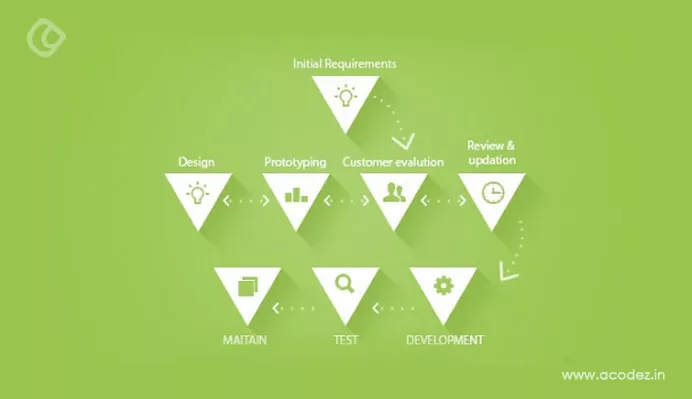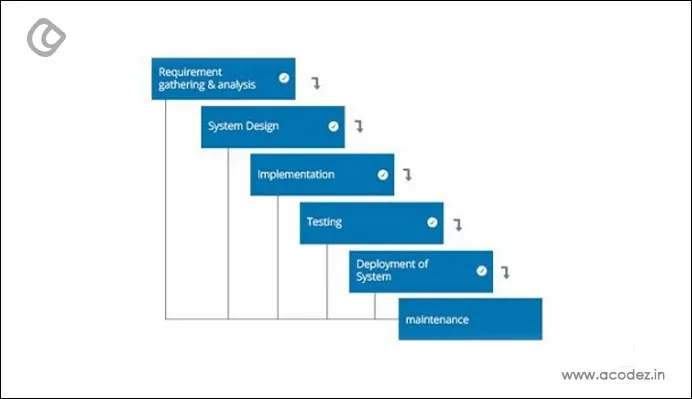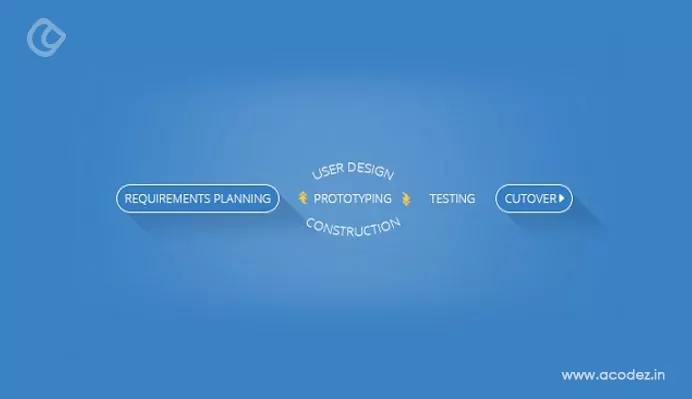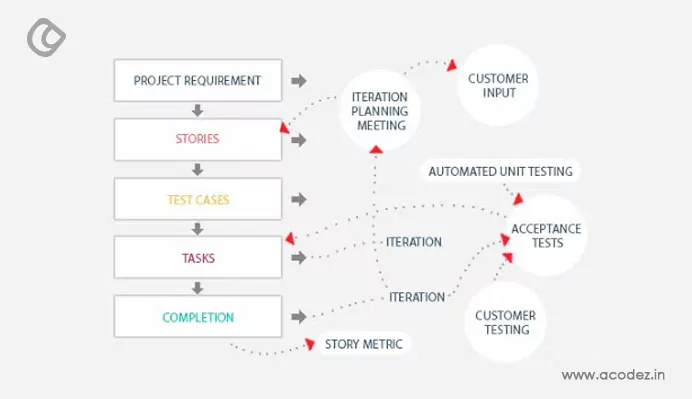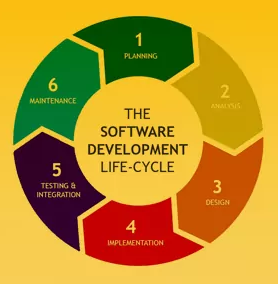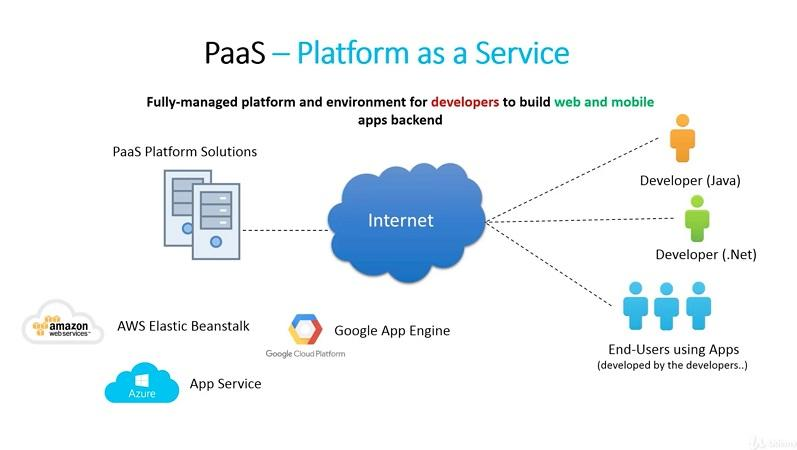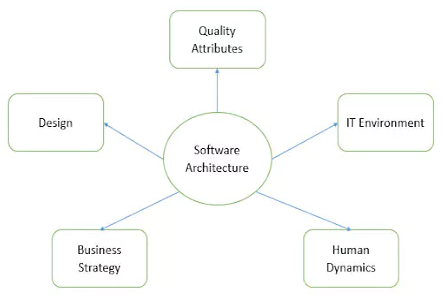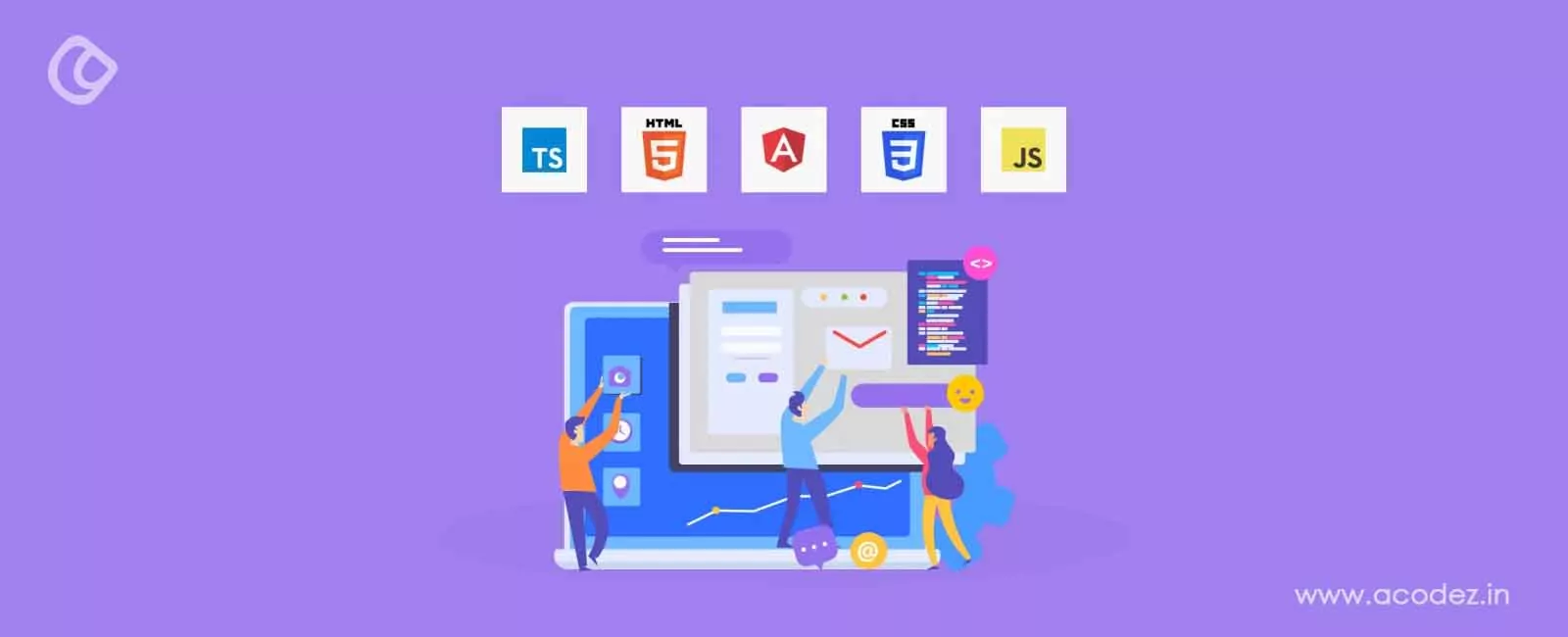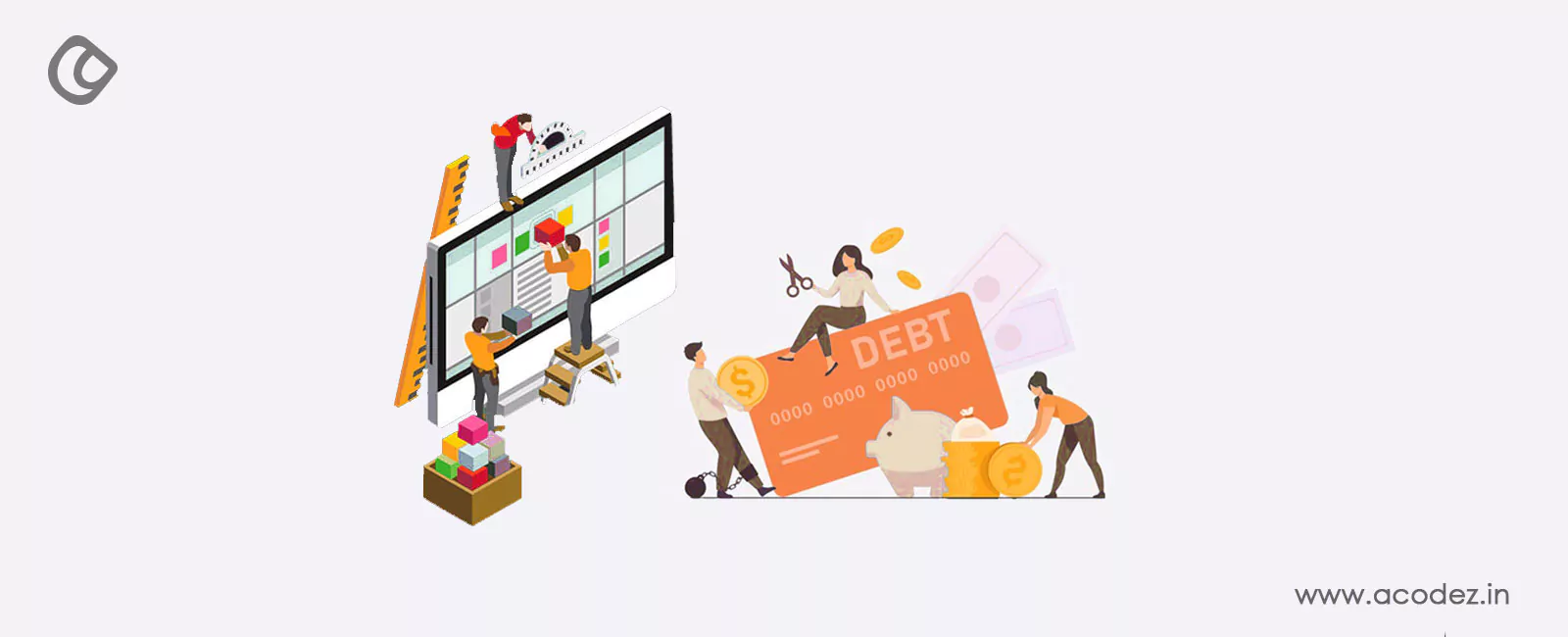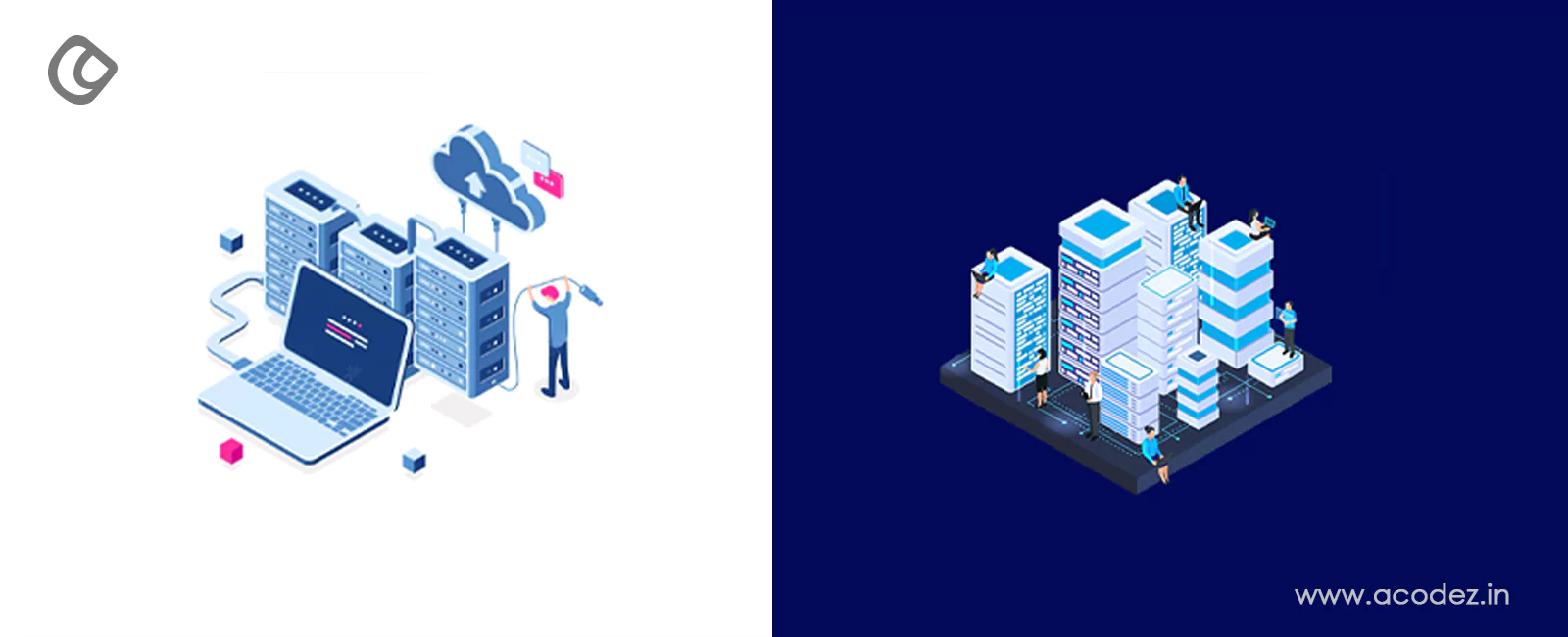Waterfall Model:
If you are in a software development company, at some point or
the other, you would have bumped into the
Waterfall Model
for a product or project.
Considered as the traditional software development method of
explaining the software development process in software engineering,
the Waterfall Development Method happens to clarify the process into
a linear flow with a specified sequence to let the users understand
that further level is made progressive on completion of the previous one.
Moreover, this methodology also talks about the fact that going
back to deal with the changes is not possible.
Pros:
- Easy to understand and functional
- Simple enough to handle as model is rigid
- Saves significant amount of time
- Allows for easy testing and analysis
Cons:
- Only matches precise needs
- Not applicable for maintenance projects
- No option to know possible outcome of a project
- Not excellent for long and ongoing projects
Prototype Methodology:
It is a specialized software development principle that
initiates developers towards making only the sample of
the resolution to validate its functional essence to the
customers and make essential iteration before creating the
authentic final product and the final QA testing.
In fact, the best part of
this methodology
is that it tends to resolve a set of diversifying issues occurring with the waterfall method.
Pros:
- Gives a clear idea about the functional process of the software
- Reduces the risk of failure in a software functionality
- Assists well in requirement gathering and the overall analysis
Cons:
- Chances of extension in management cost
- Excessive involvement of client can affect processing
- Too many changes affect the workflow of the software
Agile Software Development Methodology:
As an innovative approach and one of the leading software development models,
the agile software development methodology
is used for articulating a well-organized project management procedure allowing
for recurrent alterations.
Certainly, Agile development methodology is one theoretical outline
for undertaking several software products and projects.
Another good thing about it is that it minimizes peril by creating
software in short time boxes, known as iterations, which happen to
last from one week to one month.
Pros:
- Agile approaches in an adaptive way that responds to changes favorably
- Allows for direct communication to maintain transparency
- Continuous Improvement in quality by finding and fixing defects quickly and identifying expectation mismatches early.
Cons:
- Focuses on working with software and lacks documentation efficiency
- Chances of getting off-track as the outcome are not clear
Rapid Application Development:
Aimed at providing quick results,
rapid application development
is a software development model which is meant to give excellent processes with
the assistance of other software approaches.
It is created to take the maximum advantage from the development software.
Undoubtedly, it is designed to augment the workability of the whole software
or web application project for highlighting the participation of an active user.
Hiring for these kinds of software engineering projects is not straightforward,
because there are many factors which you need to take into consideration.
This article from Collectiveray discusses a few ways how to find
app developers
for your next project.
Pros:
- Makes the entire development process effortless
- Assists client in taking quick reviews
- Encourages feedback from customers for improvement
Cons:
- Dependant on the team for performance
- Works on modularized system confined on this methodology
- Requires extremely skilled personnel to handle complexities
- Not applicable for the small budgeted projects
Dynamic System Development Model Methodology:
Authentically formulated and derived from the rapid application
development methodology, it is an iterative and incremental
approach that focuses on the involvement of the user.
The task of this methodology or principle is to provide software
development workflow within the specified time frame and the allocated
budget.
The very reason why it is quite in demand in the world of software development.
Pros:
- Users getting a grip of the software development process
- Functionality deliverables are quick
- Offers easy access to end-users by the developers
Cons:
- This methodology is costly to implement
- Not suitable for small organizations
Spiral Model:
Being a highly sophisticated design, it is meant to reduce the
early risks in the project.
As per the software development process going by, the developers
initiate on a smaller level and explore the included risks in it.
Further to this, the developers are intended towards crafting a
plan for iterating the spiral.
The accomplishment of any
Spiral Lifecycle model
is based on consistent, observant, and conversant management of the project.
Pros:
- Risk factors are considerably reduced
- Excellent for large and complex projects
- Allows for additional functionality later
- Suitable for highly risky projects with varied business needs
Cons:
- Costly model in software development
- Failure in the risk analysis phase may damage the whole project
- Not appropriate for low-risk projects
- Might get continued and never finish
Extreme Programming Methodology:
Extreme programming is identified by the fact that customer
involvement in the software building process is unbelievably high.
As an agile software engineering methodology,
extreme programming methodology
is presently known as XP methodology.
It is chiefly used for crafting software within a very unbalanced atmosphere.
It enables greater tractability within the modeling procedure.
The foremost aim of this XP model is to reduce the cost of software essentialities.
It is fairly mutual in the XP model that the price of altering the requirements
on future stages in the project can be really whooping.
Pros:
- It lays focus on customer involvement
- Establishes rational plans and schedules
- Developers are exceptionally committed to the project
- Equipped with modernistic methods for quality software
Cons:
- Effectiveness depends on the people involved
- Requires frequent meeting for development raising total costs
- Necessitates for excessive development changes
- Exact possibilities and future outcomes are really unknown
We will take you through some of the add-on values that you can enjoy when using XP:
Communication
In XP, the process of communication is simple, robust, and fairly transparent.
Each of the team members is dependent on one another and share knowledge within
the team – which means that each member is aware of the role and functionality of the other
Simplicity:
Since the communication stage itself begins with a simple and transparent approach,
simplicity is guaranteed across all other phases. Moreover, in this context, simplicity
refers to implementing an approach where you cut all the crap and include
only the necessary information.
Feedback
With feedback, it is easier to track down the areas where improvement can be
brought about along with modification in the processes that are being
applied here, so as to ensure the product quality.
Motivation
Courage is nothing but a set of actions if implemented that might be
harmful to the team and the business requirements that will be performed.
So, with motivation, you can now work on identifying those grave factors that
might affect your services.
Extreme programming connects five different individuals
in a team and these include customer, coordinator, programmer, quality
assurance tester, and a tracker.
Pros:
- It lays focus on customer involvement
- Establishes rational plans and schedules
- Developers are exceptionally committed to the project
- Equipped with modernistic methods for quality software
Cons:
- Effectiveness depends on the people involved
- Requires frequent meeting for development raising total costs
- Necessitates for excessive development changes
- Exact possibilities and future outcomes are really unknown
Feature Driven Development:
Being an iterative methodology for software development,
it is aimed at serving a large number of teams working on a
project based on
object-oriented technology
This sort of model is decent for companies that are passing on
from a phase-based method to an iterative approach.
It is already known as an
FDD methodology
and is highly functional and creative enough to deal with varied complexities.
Pros:
- Moves bigger projects with continuous success
- The easiest 5 procedures bring outcome in a better manner
- Built on pre-set standards of software development, it is programmed for easy execution
- Projects that need continuous updates are powered by a feature-driven methodology
that ensures all needs are taken care of.
- Results in features that always outshine the inputs
- Since this is based on some of the best software building practices, any
developer with relevant experience can handle and manage project-related tasks with ease.
Cons:
- Not suitable for smaller projects and a single developer – always a huge team is required,
which means that we cannot ever guarantee a brisk deadline release.
- Highly dependable on the leading developers, necessitating for the complete structure –
the process needs to be monitored through each phase as even a
minute flaw can create chaos in the system.
- Highly dependable on the leading developers, necessitating for the complete structure –
the process needs to be monitored through each phase as even a minute
flaw can create chaos in the system.
Joint Application Development Methodology:
The
Joint Application Development Methodology
is a requirements-classification
and user-interface expansion approach that necessitates for the end-users, clients,
and developers to attend a powerful off-site conference to accentuate and confirm the software system.
This methodology serves towards including the client in the design and expansion of an application.
This is effortlessly proficient through a sequence of concerted workshops known as JAD sessions.
It tends to lay emphasis on the business difficulty rather than methodical details.
Pros:
- Allows for simultaneous congregation and alliance of excessive information.
- Produces a huge amount of valuable information in a short period
- Immediate resolving of differences with suitable assistance
- Provides a forum to explore multiple points
Cons:
- Takes excessive amount of time for planning and scheduling
- Requires significant investment of time and effort
- Calls for highly trained experts, which is tough to find
Lean Development Methodology:
As a technical advancement,
Lean Development model
lays emphasis on the formation of effortlessly manageable software.
This exquisitely designed methodology is more deliberately engrossed than any other form of agile methodology.
The objective of this procedure is to improve the software in one-third of the time, with a very restricted
budget, and a very fewer amount of essential workflow.
Pros:
- Lower budget & time requirements
- Allows for delivery of product early
Cons:
- The workability of the team decides the success of the software development process
- An unsuitable business analyst can be severely problematic
- Excessive flexibility leads developer to lose focus
Rational Unified Process Methodology:
Smartly called RUP,
Rational Unified Process methodology
powers software development using rational tools.
This methodology segregates the expansion process into four different stages that each include
business modeling, scrutiny and design, enactment, testing, and disposition.
This is an object-based and web-empowered program growth methodology.
The model tends to assist software developers in stating guidelines, templates,
and specimens for all features and stages of software development.
Pros:
- Lays high focus on precise documentation
- Removes project risks linked with client evolving needs
- Very less requirement for integration
Cons:
- Needs excessively expert software developer
- The development procedure of the methodology is complicated
- Integration might cause confusion
- Very complicated to understand
Scrum Development Methodology
SCRUM is the most widely preferred agile development approach for most software teams- which is actually an agile framework.
(Likewise, KANBAN is a process that helps teams to collaborate and work effectively.) Basically, this excellent methodology is
suitable for those software projects that are constantly altering or having extremely scaling requirements.
The
Scrum Software development model
initiates with ephemeral planning, conference and completes with a concluding review.
This methodology is used for building software that happens to include a series of iterations to generate the required software.
It is a perfect approach because it effortlessly brings on track the deliberate progressing projects.
Pros:
- Decision making lies in the hands of the team
- Business requirement document is considered insignificant
- Lightly controlled method empathizing with constant updating
Cons:
- The processing method suffers because of wavering costs
- Not suitable for big sized projects
- Requires highly expert team, which has no place for novices
V Model
The consecutive V-shaped process that develops in this method is normally referred to as the verification process or validation.
Under this, each phase is concluded with a test process that will be suitable for low-sized project and medium-sized projects.
The testing phase is occupied in parallel with planning and deployment and it includes four important types which are unit, integration, system testing, and acceptance.
Pros:
- Early detection of the errors
- Easy to implement
- Suitable for small projects
Cons:
- Least flexible and rigid model
- It will lead to creat significant issues due to the changes in the middle of the deployment phase
- It is time-consuming to create error reports at the earliest stages.
DevOps Methodology
DevOps is a software development methodology that helps software development and IT-based operations function together in the entire service lifecycle starting from design through the development process to production support.
Normally, these two teams work in their own silos, but DevOps technology permits them to collaborate and encourage project implementation. It provides a base for building, testing, and releasing software in a short time by enabling efficient communication between the teams. It also ensures better results and allows to deliver products on a continual basis.
Pros:
- Faster time to market
- Reduces risk
- Increases collaboration
- Enhances Efficiency
Cons:
- Lack of meaningful metrics
- High costs
- Added complexity
- Unrealistic goals.
Technology has paved way for many drastic changes in software development
which even have changed the approaches to software programming.
The main thing in this aspect is that it deals with a variety of
complexities, which require expert handling.
Software development has specified methodologies that work on certain platforms,
which allows them the freedom to operate.
This calls for high-quality performance under the guidance of professionals,
who have years of experience in handling technical issues with efficiency.
With varied forms of methodologies applicable to a different set of software development projects,
the developers have loads of options to create excellently working software.
It is the world of technology that everyone is looking at, and the constant changes
have led to various software developments.
It is the methodology of creating useful software that adds value to the overall
business procedure and creates ways for technical methodologies.
Also, pair any methodology of your choice with robust
project management tools
to benefit your business model.
The essential factor of developing high-quality software is that they simplify
complex procedure; but, requires an extensive way of dealing with
technicalities and expert knowledge.
It is the support of agile teams and experts that every software product works
efficiently; otherwise, they tend to spoil the entire process.
What kind of software methodologies do you utilize in your organization?
Share your thoughts, feedback, and comments with us.
Acodez IT Solutions is a
web development company in India
offering web design and development services along with mobile
app development solutions. We are also an
SEO agency based in India
offering A to Z digital marketing solutions that will help take your business to the next level.
For further details on how we can help your business,
contact us today.
